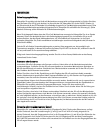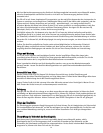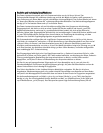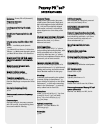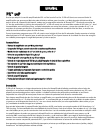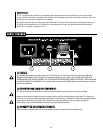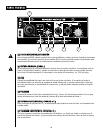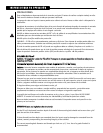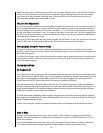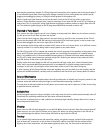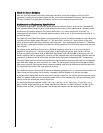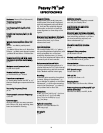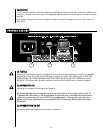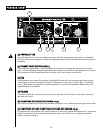
28
GGeettttiinngg AACC PPoowweerr TToo TThhee PPRR
™™
1100PP
The PR 10P comes with an 8-foot IEC connection AC power cord. If you are using an extension cord or power
strip with this powered speaker, make sure it is of good quality and of a sufficient current capacity to maintain
safety and maximize the power output capability of the PR10P. Do not connect any other device to the same
extension cord that the PR 10P is connected to.
SSppeecciiaall NNoottee ffoorr PPeerrmmaanneenntt IInnssttaallllaattiioonn
When installing the PR 10P, AC power runs will be used and a certified electrician should be consulted to
be sure that all AC wiring complies with local codes and regulations. It is also advisable to use a cable clip
properly affixed to the cabinet to strain relief the IEC power cord connected to the amplifier module at (2)
so the power cord cannot be pulled out or vibrate loose.
UUssee ooff PPRR 1100PP wwiitthh aa SSuubbwwooooffeerr
The built-in pole adapter allows use with the Peavey SP Subcompact 18X and the accessory pole that it is
designed to use, Peavey part #00326540.
The pole used is 36 3/16" long and has a nominal diameter of 1 3/8".
GGeettttiinngg aa SSiiggnnaall ttoo tthhee PPRR 1100PP
There are a variety of ways to input a signal to the PR 10P.
The primary input (5) provides either a balanced mic- or line-level input, allowing the use of a 1/4" phone
plug, either a standard single-ended (tip-sleeve) plug or a balanced TRS (tip-ring-sleeve) type plug OR a
male XLR plug. Then there are two line-level unbalanced 1/4" phone jacks that can be mixed in with the
primary input.
Do not connect cables to the jacks while the unit is ON and the Volume is turned up!
While a standard single-ended 1/4" phone plug-equipped cable will work well, and the balanced input
circuitry of the primary input (5) will provide some interference rejection, a balanced cable using either the
balanced TRS 1/4" phone plug or the XLR plug will provide superior interference rejection and
performance. Sometimes, with difficult interference problems, it will be helpful to lift the shield ground on
a balanced cable at the PR 10P end only. Check any input changes carefully, always turning the volume
control down before plugging and unplugging cables.
Use of high quality, premium cables is recommended for the PR 10P, as these usually have better shielding
and materials and will provide greater long-term reliability. It is usually a good idea to leave some slack at
the input to the PR 10P and also to tape the cables down or run them under a cable guard to avoid anyone
tripping over them or pulling the PR 10P over when stand mounted.
VVoolluummee CCoonnttrrooll AAddjjuussttmmeenntt
The PR 10P is equipped with a volume control to facilitate use in many different applications. With the
volume control adjusted fully clockwise, gain is at maximum and the input sensitivity is 0.375 V RMS for
full rated output. When driving the PR 10P from a mixer, it may be advantageous to reduce the input
sensitivity by turning the volume control to the halfway point. The PR 10P will now more closely match a
typical power amp.
If the mixing board indicates clipping of it’s output signals, then all of the PR 10P power capability is not
being utilized cleanly. Clipping the signal before it gets to the PR 10P is not optimal. Reduce the mixer
output level and turn up the volume control on the PR 10P.
The amplifiers in the PR 10P are equipped with DDT
™
and an LED indicator to show that DDT
™
has engaged.
If the sound seems heavily compressed, check this indicator; and if it is blinking RED more than
occasionally, then the drive level from the mixer (or the volume control on the PR 10P) needs to be
reduced.



